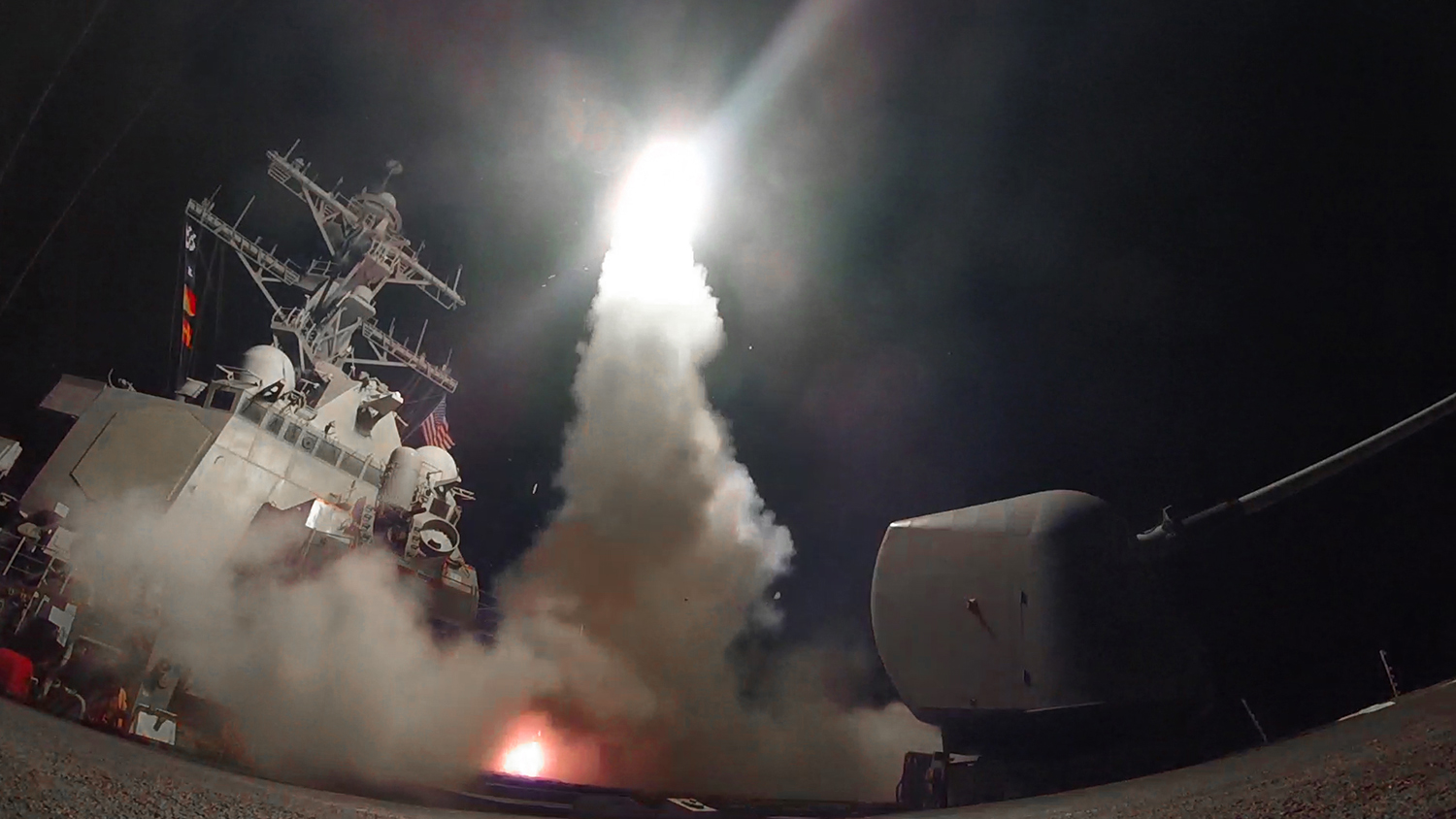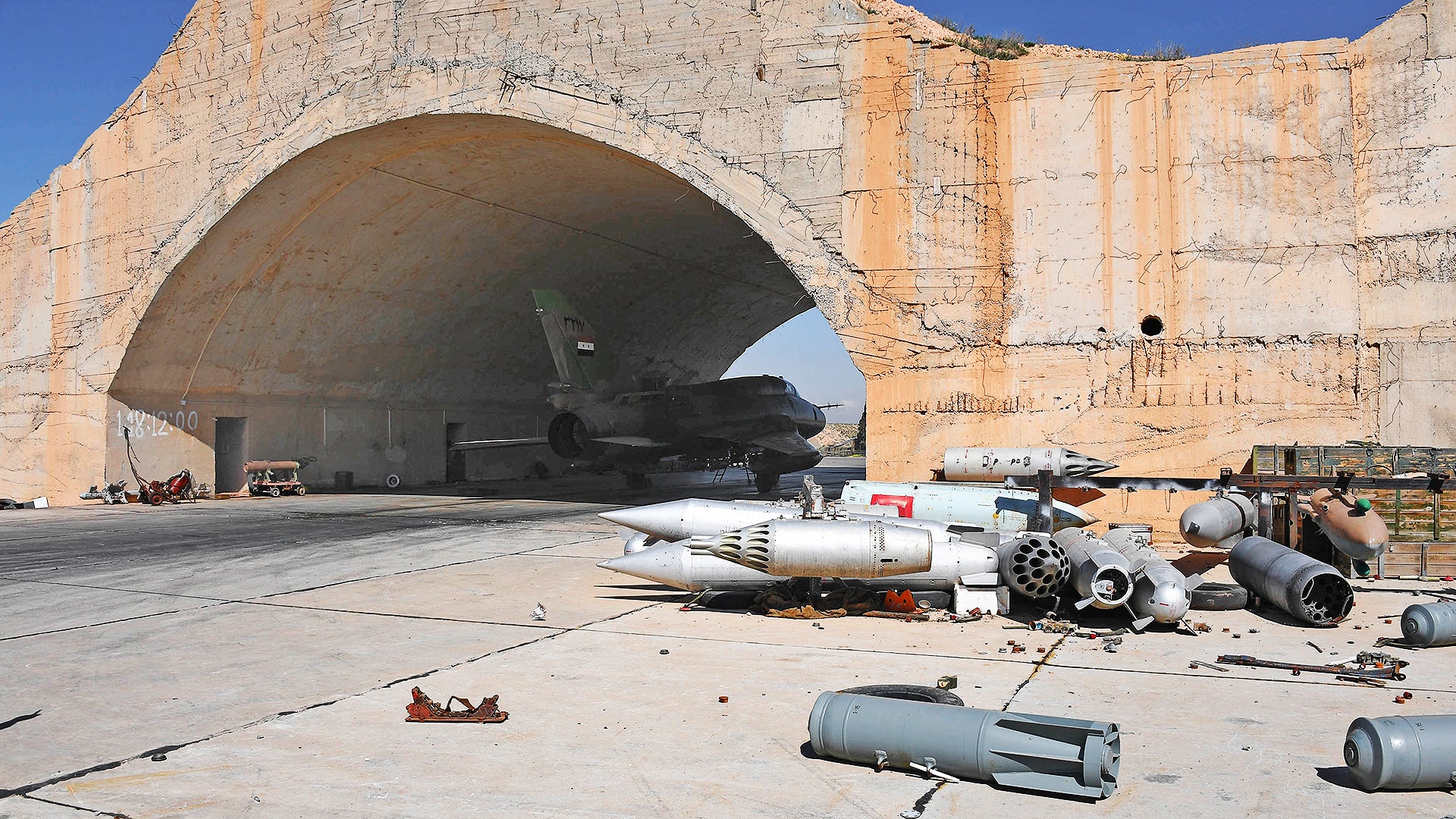Shortly before two US Navy destroyers let 59 Tomahawk missiles fly, I wrote in detail about why striking Syrian dictator Bashar al Assad’s forces now, in revenge for gassing his own people, was a terrible idea. After a picture of last night’s missile attack on Shayrat Air Base has become clearer, I can tell you that this operation wasn’t only counter-productive, it was a sham.
In an age where BS seems to comes first, and “alternative facts” have been weaponized for mass consumption on an unprecedented scale, the decision to toss $100 million worth of cruise missiles at a token target and claim doing so was a measured response for the throngs killed or hurt by Assad’s heinous gas is not surprising. But the fact that so many of our leaders are playing it off as some incredible act—and so many cable news pundit generals seems just giddy to see some action to talk about—is downright troublesome.
When considering any military action, one has to weigh the many dimensions of cost versus benefits, both near and short term. Simple questions like “does this act have a true military purpose? Does this act make America more secure? Does this act bring America closer to achieving its overall goals in a region? Will this act further endanger our soldiers?” are just a few questions among many that have to be considered carefully. The attack on Shayrat Air Base fails the vast majority of these tests glaringly.
Unless you count old concrete as a weapon system or enemy, last night’s strikes did no substantial damage to Assad’s war fighting capability. A few hardened aircraft shelters were damaged, along with a handful of old tactical aircraft—their prior serviceability unknown—and some smaller buildings and miscellaneous material were harmed. The strike did not even take out the base’s runway or taxiways temporarily, meaning more missions can be flown from Shayrat in the near term. Even the base’s air defenses were left intact.
Some of this has to do with the fact that the Russians, which have had a strong presence at the base in recent years, were warned well in advance of the strike, and apparently the Syrians were as well. Most of the aircraft were likely moved to other locations, as were high-value materials and personnel. Killing Russians, even if they were complicit in the gas attack, is not a good thing. But if a warning made good strategic sense, why leave anything at the airfield intact after giving said warning? The answer to that question is extremely frustrating.

Tomahawk Land Attack Missiles (TLAMs), in their normal configuration, are not well suited for the target set at hand. Their standard unitary warheads are capable against non-fortified structures and material, but are not capable of laying waste to a hardened airfield, at least not alone. On the other hand, their use is extremely low risk—which makes them a favorite of politicians—as no aircrews are put in harm’s way during an attack. But is a target like Shayrat Air Base even worth striking at all if you are not willing to use the proper weapon system, or combination of weapon systems, to do it? In effect, by sending throngs of TLAMs against hardened aircraft shelters and the like, commanders are knowingly putting the missiles to work in a symbolic gesture, with limited expected results.
A trio of B-2 Spirit stealth bombers, with their ability to sling 16 2,000lb “bunker buster” JDAMs, or up to 80 500lb JDAMs each, would have left that airfield, its runway, its hardened aircraft shelters and air defenses in ruins. This is why the B-2 was used to go after Libya’s key airfields during operation Odyssey Dawn, not some of the nearly 200 TLAMs fired during that military excursion. If you are going to go after a highly limited target like a single airfield, which is a very questionable decision in itself, at least get the job done. Not just that, but B-2s could have also done the job also at very low risk, and could have approached the target from the east, instead of having to fly over Russia’s air defenses along the Syrian coast. F-22s would have given the B-2s proper counter-air cover, if even that was needed which is unlikely.
Even a strike package of various fighter aircraft—some acting in the counter-air, strike and wild weasel roles—as well as electronic warfare aircraft, aerial surveillance support aircraft and bombers, such as the B-1B, could have turned that base into rubble, although with a higher assumed risk and mission complexity than just using the B-2s.
And no, the no-goodnicks of the world are not cowering in fear of America once again because Trump decided to toss some missiles at a throwaway target. They aren’t as easily duped as the average cable news viewer. These bad guys have teams of people to closely evaluate the threat the US poses to them and their capabilities—it’s called a military—and seeing the US throw 59 $1.5 million Tomahawks at an old and tired Syrian satellite airfield with little effect makes us look weak and stupid, not strong. Also, if Assad and Russia have missile capabilities that not even the B-2 and all of America’s electronic warfare, suppression of enemy air defenses, and cyber intrusion capabilities can deal with than what can these assets do against a major peer-state competitor? Once again, the choice of how to destroy the target has hurt America’s military credibility, not helped it.

In the end, no we didn’t go after Assad’s air force, or even his air defense capabilities. In fact we didn’t even go after his deadly gas. So as far as Assad is concerned, militarily nothing has changed for the worse. And despite what you hear from the giddy generals, Assad has not paid for his dastardly acts, he didn’t even receive a slap on the wrist. But still we have to pay for this attack in the form of major repercussions nonetheless.
Just as predicted, Russia has now pulled out from their agreement with Washington to work to deconflict the crowded airspace over Syria so that coalition aircraft don’t end up in a shooting match with Russian aircraft. Not just that, but now we have no way to get in touch with Russian commanders if Syrian or Russian jets bomb American or allied forces. And the hotline setup under this agreement is no theoretical game of geopolitical paddy-cake. It has been used numerous times before. Now that this no longer exists—and yes our commanders in Baghdad have said the line has gone dead—our troops and aircrews are in far greater danger than they were before. Not just that, but there is a much better chance that a relatively small incident that could be forestalled from spinning out of control with a simple call will now lead to a far darker place.
The Kremlin has also said that they will now re-equip Assad with high-end air defenses as a result of the attack, something Russia has held off from doing for some time. Currently there is a single Russian S-300 battery in Tartus and an S-400 battery at Russia’s airfield south of Latakia. These are very capable systems that Russia has not pointed at US or coalition aircraft as they go about the air war against ISIS and other extremist groups in the country. Russia has now announced that it will use these systems to defend Assad’s own military capabilities and airspace.

Assad, even with his older air defense systems, has had a tacit agreement with the US not to engage coalition aircraft if the US does not bomb his forces, and especially not his air defense or air combat capabilities. That deal is now also toast. Our aircraft, many of them defenseless against radar-guided surface-to-air missiles, will now be flying under threat in the skies over Syria. Add the fact that Russia will likely deliver long-range advanced air defense systems to Assad, and you have what amounts to a total change in the aerial equation over Syria—and that change will greatly increase the complexity and danger of America’s fight against ISIS in the region. It will also make future attacks on Assad’s military capabilities far more perilous. The worst part—all this was totally predictable.
Why this all matters is that we are supposed to be laser-focused on defeating ISIS, and primarily on sacking the capital of their so-called Caliphate in Raqqa. As I have explained in my earlier piece, we have gone through great lengths to keep the airspace over Syria open to our coalition’s drones, helicopters, surveillance and attack aircraft, by not getting drawn into Syria’s larger civil war. Now all that work, some of it at great risk, has been jettisoned for a useless “revenge” strike. The fight against ISIS, what should be our preeminent focus, is now going to be much harder after yesterday’s act. And the change is coming right when we have the Islamic State’s seat of power finally in our sights.
I would love to be able to cheer on Assad’s demise, or even the neutering of much of his war fighting capability at the hands of American air power. What he did to those innocent people, and to his own country as a whole is atrocious. But I am not stupid enough to not realize that doing so will only put our greater goals and national interests in danger in the process. And more than anything else, it now puts our soldiers at far greater risk in Syria than they were on April 6th. And in return we have nothing to show for it militarily. Assad still has his air force, his air defenses, even his gas. In fact, he still has the same airfield and much of its material that we slung 59 cruise missiles at. Don’t be surprised if fighter aircraft begin flying operations once again from Shayrat Air Base’s untouched runways this afternoon. On top of it all, now Russia is going to protect Assad’s airspace with their advanced missile batteries and are going to rebuild Assad’s own air defenses to boot. And no, the bad guys around the world aren’t any more scared of us than they were a day ago, in fact they are almost certainly less scared.

There will be a time and place for Assad and his evil henchmen to get what is coming to them, but yesterday was absolutely not that time. The operation displayed a lack of vision, understanding about the limitations of our military capabilities, and a total vacancy of strategic thought by all who were involved with it, and that is very worrisome to say the least. Sometimes doing nothing is a far better decision than “doing something.” In this case that wisdom was overcome by reactionary thinking by leaders that don’t have the long-game in mind and Assad is the benefactor of their nearsightedness.
In the end you have to ask yourself: are America’s interests in the region better off today than they were before yesterday’s strike? Across the board the answer is clearly no.
Contact the author: Tyler@thedrive.com
